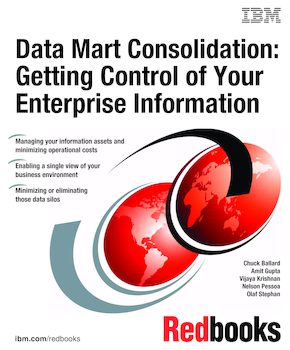Data Mart Consolidation: Getting Control of Your Enterprise Information
An IBM Redbooks publication
Note: This is publication is now archived. For reference only.

Published on 02 August 2005, updated 16 August 2005
ISBN-10: 0738493732
ISBN-13: 9780738493732
IBM Form #: SG24-6653-00
Authors: Chuck Ballard, Amit Gupta, Vijaya Krishnan, Nelson Pessoa and Olaf Stephan
This IBM Redbooks publication is primarily intended for use by IBM Clients and IBM Business Partners. The current direction in the Business Intelligence marketplace is towards data mart consolidation. Originally data marts were built for many different reasons, such as departmental or organizational control, faster query response times, easier and faster to design and build, and fast payback.
However, data marts did not always provide the best solution when it came to viewing the business enterprise as a whole. They provide benefits to the department or organization to whom they belong, but typically do not give management the information they need to efficiently and effectively run the business.
In many cases the data marts led to the creation of departmental or organizational data silos (non-integrated sources of data). That is, information was available to the particular department or organization, but was not integrated across all the department’s or organizations. Worse yet, many data marts were built without concern for the others. This led to inconsistent definitions of the data, inconsistent collection of data, inconsistent collection times for the data, and so on. The result was an inconsistent picture of the business for management, and an inability for good business performance management. The solution is to consolidate those data silos to provide management the information they need.
Chapter 1. Introduction
Chapter 2. Data warehousing: A review
Chapter 3. Data marts: Reassessing the requirement
Chapter 4. Consolidation: A look at the approaches
Chapter 5. Spreadsheet data marts
Chapter 6. Data mart consolidation lifecycle
Chapter 7. Consolidating the data
Chapter 8. Performance and consolidation
Chapter 9. Data mart consolidation: A project example
Appendix A. Consolidation project example: Table descriptions
Appendix B. Data consolidation examples
Appendix C. Data mapping matrix and code for EDW
Appendix D. Additional material